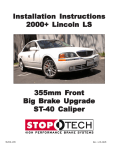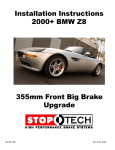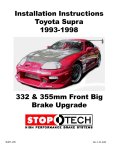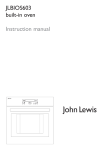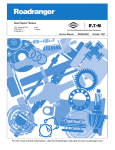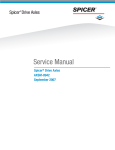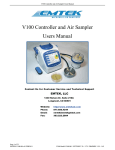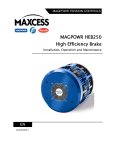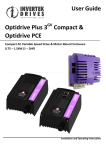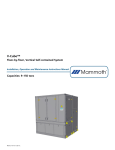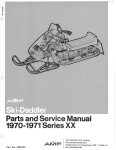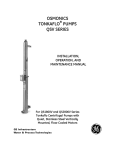Download StopTech Automobile Parts 98-180-1470 User's Manual
Transcript
Installation Instructions Corvette C5 1997 - 2004 355mm Front Big Brake Upgrade ST-40 Caliper 98-180-1470 Rev. C 03-02-06 COMPONENT IDENTIFICA TION IDENTIFICATION 355mm AeroRotor and Hat Assembly ST-40 Caliper Stainless Braided Brake Line and Hardware Caliper Bracket High-Performance Street Pads Big B rake K it for the Cor Brake Kit Corvvette C5 (This is a representative photograph. The actual components in your kit may appear slightly different.) 3541 Unit A, Lomita Boulevard, Torrance, CA 90505 (310) 325-4799 www.stoptech.com 2 APPLICA TION DISCL AIMER APPLICATION DISCLAIMER Caliper Clearance Most 17” wheels will clear the outer diameter of the caliper for a 328mm or 332mm rotor kit. For a 355mm kit, a minimum 18” wheel is typically required, and for a 380mm rotor kit, a minimum 19” wheel is needed. The more critical clearance, however, is the gap between the spokes of the wheel and the face of the caliper. Do not assume that a larger-diameter wheel will automatically clear the face of the caliper. To determine the actual metal-to-metal distance from the stock rotor face to the inside of the wheel .stoptech.com spokes, refer to the StopTech website at www www.stoptech.com .stoptech.com, and click on the ‘Wheel Fitment’ link in the ‘Technical Information’ section. Review the instructions carefully, to ensure that you have a full understanding of how to accurately measure the critical wheel clearances. It is very important that you verify the accuracy of the scale of the printout by matching both a width and length dimension on your vehicle. Dimensions are shown in millimeters, but one dimension in each direction is also shown in inches, and StopTech recommends adding at least 2mm of additional clearance to these dimensions. Follow the instructions carefully, to produce a fitment template, and take care to ensure that your measurements are very precise. If you have any questions or difficulties, please contact the StopTech Customer Service Department on (310) 325-4799 extension 105, or send an e-mail to [email protected] [email protected]. Note: F inal fitment of the wheel to the caliper is the rresponsibility esponsibility of the customer Final customer.. Wheel Spacers Wheel spacers can provide extra clearance to the outer face of the caliper. This will also space out the entire wheel, widening the track width of the vehicle. Fender clearances should be checked on lowered cars, and longer lug studs or wheel bolts are usually required. Note: The Wheel Industry Council has issued guidelines advising that wheel spacers not be used. It is the responsibility of the customer to ensure that wheel spacers are properly specified and installed. Caliper at and B racket F inish D isclaimer aliper,, H Hat Bracket Finish Disclaimer Many wheel-cleaning solutions contain strong acids that may damage the finish on any caliper or aluminum anodized finish, especially the plating on the hardware. Check for adverse effects by trying a small amount of the cleaner in question on an inconspicuous area. Avoid over-spraying, and rinse cleaning solutions off as quickly as possible. StopTech is not liable for damage to calipers, hats or bracket finishes, due to corrosive chemical exposure. 3541 Unit A, Lomita Boulevard, Torrance, CA 90505 (310) 325-4799 www.stoptech.com 3 APPLICA TION DISCL AIMER (Cont APPLICATION DISCLAIMER (Cont’’d.) Brake N oise Noise Certain brake pad compounds make more noise than others. Proper anti-squeal shim plates between the caliper pistons and backing plate of the pad help to reduce the problem. Anti-squeal lubricants are also available, to reduce some of the noise. The reality is that performance pads are more prone to brake squeal. Note: The customer is responsible for any squeal-related problems due to pad selection. Per manent M odification to Lo wer B all JJoints oints ermanent Modification Low Ball It may be necessary to grind a portion of each lower ball joint, to clear the inboard face of the rotor during full suspension travel. If done carefully, this modification will not affect the strength or structural integrity of the vehicle. Although a coarse file will remove the material, a power grinder, if used properly, will be more efficient. If you are uncomfortable making this modification, seek the help of a qualified professional. Brake Vibration - THIS IS IMPOR TANT! IMPORT The most common cause of brake vibration is improper bed-in of pads and rotors, or improper pad selection for the specific driving environment. Rotor run-out may also cause vibration, but precision manufacturing and inspection typically mean that run-out is not an issue. Modern production methods ensure that the rotor run-out is within +/- 0.002” when installed on a StopTech aluminum hat, and it controls thickness variation to within 0.0003”. Under the most extreme conditions, any rotor may warp, but uneven pad deposition is a more typical cause of vibration. If the system is not properly bedded-in, or if street pads are run on an open track, uneven pad deposits will occur, causing an ever-worsening vibration. Failure to immediately address a pad deposition/vibration issue may lead to permanent damage of the rotors. Please read and understand the bed-in procedure included in this manual. If you have any questions, please contact the StopTech Customer Service Department on (310) 325-4799 - extension 105, or you can e-mail directly to [email protected] [email protected]. Note: S topT ech is not liable for vibr ations caused by eextr xtr eme usage or impr oper bed-in of StopT topTech vibrations xtreme improper pads and rotors. All trademar ks ar oper ties of their rrespectiv espectiv wners. SStopT topT ech LL C is neither associtrademarks aree pr proper operties espectivee o owners. topTech LLC ated nor affiliated with, nor sponsored by General Motors. 3541 Unit A, Lomita Boulevard, Torrance, CA 90505 (310) 325-4799 www.stoptech.com 4 Impor tant N otices mportant Notices Wheel Fitment Do not assume that your wheels will fit. An outline drawing of your StopTech Big Brake kit is .stoptech.com available in the ‘Technical Information’ section of our website at www www.stoptech.com .stoptech.com. Measure the distance from the outer face of your stock caliper to the inner face of your wheel spokes, or make a template according to the instructions on the website, to determine if a wheel spacer is necessary. DO THIS BEFORE YOU INSTALL YOUR KIT! Cleaning of Rotors The AeroRotors supplied with this kit are coated with a water-soluble, environmentally friendly rust inhibitor. This coating MUST BE WASHED OFF WITH SOAP AND WATER before installation. Brake cleaner is not as effective as soap and water. Even if it doesn’t look as if anything is coming off the rotor, the rust inhibitor is there, and must be entirely cleaned. Rotors will quickly rust without protection, so if the rotor is not rusty, it’s still coated. After cleaning, you may see the rotor start to develop a slight rust color. This is normal, and indicates that all of the rust inhibitor has been removed. Rotor and P ad Bed-in Pad Proper rotor and pad bed-in is essential to the performance of your new brake system. Failure to properly bed-in the brakes will seriously impact how well they work, and how long they will last. The number one cause of brake vibration is uneven pad material deposition on the rotor. Proper bed-in will greatly minimize such problems. Follow, as closely as possible, the bed-in procedure .stoptech.com for further www.stoptech.com detailed later in this manual, or refer to the StopTech website at www information. Safety N otice Notice Improper handling of a vehicle, especially while raised and supported by jack stands, ramps or other mechanical means, can cause serious bodily injury or even death. It is strongly recommended that a trained, experienced mechanic, with proper equipment, install the Big Brake Kit supplied by StopTech LLC. StopTech LLC assumes no liability, expressed or implied, for the improper installation or use of this product or its components. Liability N o Warranty No Automobile racing and performance driving, whether sanctioned or not, on or off the road, are dangerous. Products used in such environments/applications are subject to stresses and conditions outside of normal use, wear and tear. All equipment sold or provided by StopTech LLC is sold WITHOUT WARRANTY, EXPRESSED OR IMPLIED. No warranty or representation is made to the product’s ability to protect the user from injury or death. The user assumes all risk. StopTech LLC is NOT responsible for any damage, consequential or otherwise, for equipment failure or malperformance after installation. Under no circumstances is StopTech liable for labor charges or loss of use. Contact SStopT topT ech topTech If you have any questions about wheel fitment, rotor cleaning, or bed-in of a particular pad type, please call StopTech’s Customer Service Department on (310) 325-4799 - extension 105, or you can e-mail directly to [email protected] [email protected]. 3541 Unit A, Lomita Boulevard, Torrance, CA 90505 (310) 325-4799 www.stoptech.com 5 Cor it Corvvette C5 F Frront Axle K Kit Note: It is important to read and understand this ENTIRE installation manual, including the bed-in procedure, before starting the installation. Kit Contents Your StopTech Big Brake kit includes the following: 1 pair of ST-40 four-piston calipers, sized specifically for your vehicle 1 set of high-performance street pads (not suitable for track use) 1 pair of 355 x 32mm two-piece rotor assemblies 1 pair of aluminum caliper adapter brackets 2 pair of 7/16-20 self-locking Jet nuts 2 pair of 12mm washers 1 pair of stainless steel brake lines 1 pair of banjo bolts 2 pair of copper crush washers 1 pair of rubber end caps 1 caplet of Loctite 262 Tools and E quipment R equir ed Equipment Requir equired Note: Different models and years of vehicle use different-sized fasteners, and every effort has been taken to correctly identify the proper sized tool for each step of the installation. Occasionally wev er ers use alter nate fasteners, so it sionally,, ho how ever er,, manufactur manufacturers alternate it’’s advisable to check that each tool correctly fits the fastener before loosening or tightening it. The following tools and equipment will be needed: 21mm wrench or socket (1/2” drive suggested) 14mm wrench or socket 13mm flare wrench 11mm box wrench 11/16” wrench 1/2” wrench or socket (3/8” drive suggested) Torque wrenches capable of 10-125 lb-ft settings 5mm Allen (hex) wrench Needle-nose or small standard pliers Coarse file or power grinder Anti-seize compound Small drip tray or several rags Small funnel or suitable means of filling master cylinder reservoir Brake bleed bottle Plastic or non-marring mallet 1 pair of jack stands or other means of supporting vehicle DOT 3 or 4 Brake Fluid (Check manufacturer’s recommendation for compatibility. StopTech recommends flushing brake fluid every one-to-two years, or more often under severe usage conditions. If not done recently, the installation of a brake kit is an excellent opportunity to refresh your brake fluid, or to upgrade to a higher-performance fluid, such as Motul 600.) 3541 Unit A, Lomita Boulevard, Torrance, CA 90505 (310) 325-4799 www.stoptech.com 6 Step 1 R aise Vehicle, and R emo Remo emovve Wheels Note: All photographs show a right-hand side installation, unless otherwise noted. A level, stable and clean surface, suitable for supporting the vehicle on jack-stands, should be used for the installation. War ning: N ev er leav ehicle suppor ted arning: Nev ever leavee any vvehicle supported with only a jack. Always use jack-stands. For a front kit installation, apply the parking brake, then break loose the lug nuts on both front wheels before jacking up the vehicle. Jack up the vehicle, and secure it on a pair of jack-stands, referring to the owner’s manual to identify the correct jack and support locations. After securing the vehicle at a convenient height, remove the front wheels. N ote: T king br ake Too ensur ensuree safety safety,, the par parking brake must be applied before removing the front wheels. If necessary, place a wheel nut on one of the studs, to prevent the rotor from falling. To make it easier to access the brake line fittings, turn the steering either toward or away from the side that you’re working on, depending on the orientation of the caliper. If you’re installing a leading caliper, turn the steering toward the side that you’re working on, and if you’re installing a trailing caliper, turn the steering away from the side that you’re working on. This will make access to the caliper bolts easier. 3541 Unit A, Lomita Boulevard, Torrance, CA 90505 (310) 325-4799 www.stoptech.com 7 Step 2 Disconnect Stock Brake Line War ning: B faces. IImmediately mmediately clean spilled br ake arning: Brrake fluid will damage most painted sur surfaces. brake fluid from any painted surface. Also be sure that the cap is securely installed on the master cylinder emo ake cylinder.. If the cap is loose or rremo emovv ed, it is likely that mor moree fluid will drip during br brake installation. Place a drip tray or several rags directly below the inboard brake line connection. If the area around the brake line connection to the chassis is dirty, clean it using brake cleaner or an appropriate cleaning agent. Use a 13mm flare wrench to slightly loosen the hard line fitting. Use needle-nose or small standard pliers to remove the bracket holding the inboard end of the stock brake line to the chassis bracket. Take care to retain the clip for later use. Remove the hard line fitting, and quickly place one of the rubber caps over the end of the hard line, to control fluid loss during the installation. 3541 Unit A, Lomita Boulevard, Torrance, CA 90505 (310) 325-4799 www.stoptech.com 8 Step 3 Remo tock C aliper & R otor emovve SStock Caliper Rotor Remove the two stock caliper bolts, using a 21mm wrench or socket, and retain the bolts for later use. Note: F actor y-installed caliper bolts may be Factor actory-installed very tight. Ensure that you have a good purchase on the bolt head, and that you are in a good position to turn the wrench or socket. Remove the caliper with the stock brake line attached. There may be some leakage from the open end of the brake line, especially if the pads/ pistons on the caliper are retracted. Remove the stock rotor, by pulling it off of the hub by hand. Note: It may be necessary to strike the outer edge of the rotor with a non-marring mallet, if corrosion prevents the rotor from simply being pulled off. If so, place a wheel bolt in one of the holes first, to prevent the rotor from falling when it comes loose. 3541 Unit A, Lomita Boulevard, Torrance, CA 90505 (310) 325-4799 www.stoptech.com 9 Step 4 Install Caliper Bracket Remove the Jet nuts and washers from the caliper mounting bracket, and put them aside for later use. Place a few drops of the supplied Loctite 262 on the threads of each stock caliper bolt. Install the caliper bracket, using the stock caliper mounting bolts, with the bracket mounted on the outboard side of the mounting lugs, and the bolts inserted from the inboard side. Tighten the caliper bracket bolts, using a 21mm wrench or socket, then torque the bolts to 125 lb-ft lb-ft. 3541 Unit A, Lomita Boulevard, Torrance, CA 90505 (310) 325-4799 www.stoptech.com 10 Step 5 Install AeroRotor Assembly AeroRotors MUST be cleaned with soap and water prior to installation. Not doing so will damage the rotors and pads, and will prevent the brakes from performing properly. Even though the rotors may look clean, the rust inhibitor is in place, and it must be removed. Not cleaning the rotors will severely impact the performance of your new brake system. War ning: D arning: Doo not skip this step! Install the hat and rotor assembly, ensuring that the rotor is seated squarely on the hub face. If necessary, clean the face of the hub, using a wire brush or similar means. Place a couple of wheel nuts on the studs, to prevent the rotor from falling during brake installation. Note: T ake car otor assembly is on the corr ect side of the car ev ersing Take caree to ensur ensuree that the rrotor correct car,, as rrev eversing the rotors will severely decrease the cooling capacity of the system. The rotors are clearly mar ked “L ” and “R ” with or ange tags on the rrotor otor hats. If the tags ar anes marked “L” “R” orange aree not legible, the vvanes inside the rotor should lean to the rear of the car on the top side of the rotor (see pages 13 and 14 for more-detailed images). 3541 Unit A, Lomita Boulevard, Torrance, CA 90505 (310) 325-4799 www.stoptech.com 11 Step 5 (Cont (Cont’’d.) Install AeroRotor Assembly It may be necessary to clearance the lower ball joint slightly, to clear the inboard face of the AeroRotor during full suspension travel. A coarse file can remove the material, although a power grinder is more efficient, if used properly. Install the rotor, and check the proximity of the lower ball joint to the inner rotor face. Turn the wheel lock-to-lock, to determine how far around the front and back edge needs to be clearanced. Note: If only the lip ar ound the outer ridge is around removed, the structural integrity of the lower ball joint will not be compromised. If you are not comfortable making this modification, seek the help of a qualified professional. Remove the lip which protrudes around the outer edge of the ball joint (the approximate area is shown in the photograph to the left). Ridge Width Remove ridge in this area With the suspension at FULL DROOP, there should be a clearance of 3.5 - 4.8mm (1/8 - 3/16) between the inner face of the rotor and the outer diameter of the lower ball joint. 3.5 - 4.8mm at full droop 3541 Unit A, Lomita Boulevard, Torrance, CA 90505 (310) 325-4799 www.stoptech.com 12 Left-Side Rotor Outboard Side Driv er river er’’s Left Right-Side Rotor Outboard Side Driv er river er’’s Right 3541 Unit A, Lomita Boulevard, Torrance, CA 90505 (310) 325-4799 www.stoptech.com 13 3541 Unit A, Lomita Boulevard, Torrance, CA 90505 (310) 325-4799 www.stoptech.com 14 Caliper Component IIdentification dentification Use a light film of anti-seize on the bridge bolt shafts and threads The ST-40 original equipment caliper uses a common Porsche-style pad. The Friction Materials Standards Institute (FMSI) number for the pad backing plate is D372. For further pad interchange information, please see the FAQ section of the StopTech website at: www.stoptech.com 3541 Unit A, Lomita Boulevard, Torrance, CA 90505 (310) 325-4799 www.stoptech.com 15 Step 6 Install C aliper and P ads Caliper Pads Note: The images in this section may not be of the vvehicle ehicle noted, but the oper theyy giv givee a pr proper representation of the correct installation. Determine the left- and right-hand side calipers. They are clearly marked on the box, but as a check, the bleed screws are always positioned at the top of the caliper. If installing a four-wheel kit, with ST40 calipers on the front and rear of the vehicle, be sure that the correct caliper is on each corner. The calipers with the smaller piston sizes go on the rear of the vehicle. Remove the two bolts holding the caliper bridge in place, using a 5mm Allen wrench. Bridge Bolts Remove the caliper bridge, taking note of the direction in which it is installed, and the correct location of the pad-retaining wire clip, which typically, but not always, remains attached to the bridge. Note: When the pad-r etaining clip is oriented pad-retaining correctly, its welded joint should not be visible thr ough the bridge through bridge’’s air-scoop opening. In order to stiffen the caliper, the bridge must fit snugly, and the bolts may be tight when removing them. Keep turning the bolts gently, with pressure applied in the direction of removal. After removing the bolts, it may be necessary to tap the bridge out from the inside of the caliper, using a mallet or similar tool (the handle of a tool works well for this). With use, the bridge and bolts will become easier to remove and insert. 3541 Unit A, Lomita Boulevard, Torrance, CA 90505 (310) 325-4799 www.stoptech.com 16 Step 6 (Cont (Cont’’d.) Install C aliper and P ads Caliper Pads Install the caliper onto the adapter bracket, orienting it so that the bleed screws are positioned on the top side of the caliper. Take care to ensure that the caliper is square and evenly started on both studs. It may be necessary to use a mallet to gently tap the caliper into position. Install a Jet nut onto each stud, with a 12mm washer under each nut. Tighten the Jet nuts to 40 lb-ft of torque, using a 1/2” wrench or socket. Slide the brake pads into position within the caliper, taking care to ensure that the friction side of each pad is facing the rotor. (Y es, the d befor e!) (Yes, theyy’ve been installed backwar backward before!) Apply a light film of anti-seize compound onto the bridge bolt shafts and threads. 3541 Unit A, Lomita Boulevard, Torrance, CA 90505 (310) 325-4799 www.stoptech.com 17 Step 6 (Cont (Cont’’d.) Install C aliper and P ads Caliper Pads Install the bridge by sliding it into position, and rocking it until one of the bolt holes lines up. Take care to ensure that the bridge is slid straight and parallel into the caliper body opening. Note: The bridge is dir ectional, and should directional, be positioned so that the air-scoop opening is located in the bottom half of the bridge. Insert the first bridge bolt, from the outside of the caliper, and start the first few threads, using a 5mm Allen wrench. Start the second bolt, and apply pressure to the bridge, using the palm of your hand, or by gently tapping the bridge with a mallet, until the bolt engages in the hole. Start the first few threads, using a 5mm Allen wrench. Double-check the orientation of the bridge, to ensure that the air-scoop opening is located in the bottom half of the bridge. Torque each bolt to appr appro lb-ft, oximately 8-10 lb-ft using a 5mm Allen wrench. Do not use a torque wrench, as the use of anti-seize compound will cause a false reading. Do not over-torque the bridge bolts - snug is tight enough. War ning: D arning: Doo not hammer the bridge bolts into place. T Tap ap the bridge, not the bolts! 3541 Unit A, Lomita Boulevard, Torrance, CA 90505 (310) 325-4799 www.stoptech.com 18 Step 7 Attach SStainless tainless SSteel teel B rake Line Brake Install the caliper end of the stainless steel brake line by first placing a copper crush washer on either side of the banjo fitting, then inserting the banjo bolt into the fitting. Copper Banjo bolt Insert the banjo bolt into the caliper, angling the banjo fitting so that it is leaning slightly forward. oximately 14 lbappro Torque the banjo bolt to appr ft, using a 14mm wrench or socket. ft Note: D que wr ench, as oovverDoo not use a tor torque wrench, tightening the bolt can strip the aluminum threads, causing irreparable damage to the caliper caliper.. Remove the rubber cap from the hard line, and screw the stainless steel brake line onto the hard line fitting by hand for a few turns. Use an 11/16” wrench to hold the stainless line fitting, while using a 13mm flare wrench to tighten the hard line fitting. 3541 Unit A, Lomita Boulevard, Torrance, CA 90505 (310) 325-4799 www.stoptech.com 19 Step 7 (Cont (Cont’’d.) Attach SStainless tainless SSteel teel B rake Line Brake Reinstall the line-retaining spring clip, to secure the stainless brake line in place. Take care to ensure that the prongs on the spring clip are seated within the recesses on the brake line fitting, then use a mallet to gently tap the spring clip into place. After securing the brake line, turn the wheels lockto-lock to ensure that the line is not binding or touching any moving part of the suspension. Adjust the line, if necessary, by re-clocking the banjo bolt on the caliper, or by reorienting the inboard line fitting. 3541 Unit A, Lomita Boulevard, Torrance, CA 90505 (310) 325-4799 www.stoptech.com 20 Step 8 Bleed Brakes Complete the installation on both sides of the vehicle before bleeding the system. Note: The calipers and lines will need to fill with fluid, quickly dr aining the master cylinder draining eep a close watch on the fluid lev el when initially bleeding the system. D w eservv oir oir.. K Keep level Doo not allo allow reser the master cylinder rreser eser un dr aw in air oing so may rresult esult in the br dryy, and to dr draw air.. D Doing brake eservvoir to rrun ake system needing to be serviced by a certified brake technician. Bleed the brake system, using an 11mm box wrench, to loosen the bleed screws. The sequence for bleeding the brakes should be: 1. Right outboard bleed screw 2. Right inboard bleed screw 3. Left outboard bleed screw 4. Left inboard bleed screw Though a torque wrench is not typically used on bleed screws, as a reference, the torque for bleed screws should be approximately 100-140 lb-INCH lb-INCH. After initially bleeding the system, gently tap the caliper body with a mallet to dislodge any small air bubbles, then re-bleed the brakes. After bleeding, apply constant pressure to the brake pedal, and check all connections - including bleed screws, and both ends of the brake line - for leaks. War ning: B faces. IImmediately mmediately clean spilled br ake arning: Brrake fluid will damage most painted sur surfaces. brake esist fluid fr om any painted sur face, including the caliper from surface, caliper.. Though caliper paint is designed to rresist harsh chemicals, prolonged exposure will damage the finish. 3541 Unit A, Lomita Boulevard, Torrance, CA 90505 (310) 325-4799 www.stoptech.com 21 Step 9 Reinstall Wheels It is very important to check the wheel-to-caliper clearance before installing wheels! Note: S ome wheels ar e-backed lead w Some aree balanced on the inside, with adhesiv adhesive-backed weights. eights. If the fer weight is on the outboar d edge, behind the spokes, it may inter outboard interfer feree with the caliper caliper.. If necessar y , note the w eight and location of the lead, and place a new piece of the same w eight fur ther further sary weight weight d, to clear the caliper ou rrotate otate the tir es rregularly egularly eight inboar outboard, caliper.. If yyou tires egularly,, check the lead w weight inboard d or outboar positions on all four wheels, and also on the spare, if it is full-sized. Reinstall the wheels, and torque the lug nuts to your wheel manufacturer’s specifications. It may be necessary to snug the bolts before lowering the vehicle, and to then torque the wheels when the car is on the ground. Alternatively, an assistant may depress the brake pedal while you tighten the wheel nuts to the proper torque setting. Carefully test-drive the vehicle in a safe area, at low speed, to ensure that all components are working correctly. Then follow the pad and rotor bed-in procedure on the following pages. 3541 Unit A, Lomita Boulevard, Torrance, CA 90505 (310) 325-4799 www.stoptech.com 22 AeroRotor Installation & Bed-in Procedure READ THIS NOW FAIL URE TO READ, UNDERST AND AND FOLL OW THESE PR OCEDURES AILURE UNDERSTAND FOLLO PROCEDURES WILL CA USE P ERMANENT DAMA GE TO YOUR BRAKE R OTORS, AND WILL RO CAUSE PERMANENT DAMAGE KEEP THE SYSTEM FR OM WORKING A T IT S FULL CAP ACIT Y. CITY FROM AT ITS CAPA The majority of brake system problems are due to improper installation and/or bed-in of the rotors and pads. By reading and understanding the following, you will avoid the most common causes of poor brake performance and vibration. FAILURE TO READ AND UNDERSTAND THIS MAY CAUSE SERIOUS PERMANENT DAMAGE TO YOUR NEW ROTORS. Wash N on-P lated A er oR otors with SO AP Non-P on-Plated Aer eroR oRotors SOAP AND WATER befor beforee installation. StopTech coats non-plated AeroRotors with a water-soluble, environmentally friendly rust inhibitor that MUST be cleaned off before use. A non-plated rotor looks like bare metal, while plated rotors are bright silver in color, and do not need to be washed. Even though you may not see a change in the rotor color, if the rotor is not rusty, the rust inhibitor is there. Use soap and water, NOT BRAKE CLEANER to wash the rotors. A small piece of Scotchbrite works well for scrubbing. When cleaned and rinsed properly, the surface of the rotor may show a light rust color, which is normal. Bed-in yyour our new pads and rrotors otors b efully obbyy car carefully ser ving the pr ocedur serving procedur oceduree described on this and the follo wing page. following Bed-in of rotors and pads is critical to the optimum performance of your new brakes. When beddingin new parts, you are not only heat-cycling the pads, you are also depositing a layer of pad material onto the rotor face. If not bedded-in properly, an uneven layer of pad material will be deposited onto tually ev er warped ” rrotor otor is attributed the rotor, causing vibration. Vir irtually ever eryy instance of a ““warped warped” to uneven pad deposition. Note: P lated rrotors otors must be driv en with gentle br aking, until the CAD plating is wor n off of the Plated driven braking, worn rotor faces, BEFORE starting the bed-in procedure. Do not use brakes aggressively until the plating is worn off, typically after several miles of driving. Typically, a heavy-braking street driver will experience approximately 1 to 1.1G’s of deceleration. At this rate, the ABS will be activated on such equipped vehicles. A moderate braking effort is needed to properly bed-in rotors and pads. If ABS intervention or lockup were represented as 100% brake effort, a stopping force of approximately 70-80%, just short of ABS intervention or lockup, is a general estimate of the pedal effort you are trying to achieve. (Continued on next page) 3541 Unit A, Lomita Boulevard, Torrance, CA 90505 (310) 325-4799 www.stoptech.com 23 Rotor and P ad Bed-in (Cont Pad (Cont’’d.) Note: B edding-in of pads should not be done in poor w eather conditions, nor on w et rroads. oads. Bedding-in weather wet After completing the installation, make a series of 10 stops from 60 to 5-10 MPH. At the end of each stop, immediately accelerate to 60 again for the next stop. Run all stops in one cycle. During the 60 to 5-10 MPH cycle of stops, the exact speed is not critical. Accelerate to approximately 60, then begin braking. As you approach 5-10 MPH, it is not necessary to watch the speedometer. Keep your eyes on the road, and approximate your speed at the end of each stop. DO NOT COME TO A COMPLETE STOP, WHILE LEAVING YOUR FOOT ON THE BRAKE PEDAL, AS YOU MAY IMPRINT PAD MATERIAL ONTO THE ROTOR, CAUSING A VIBRATION. If racing or higher-performance pads are being used, add four stops from 80 to 5-10 MPH, and if full race pads are being used, add four stops from 100 to 5-10 MPH. There are several indicators to look for while bedding-in the system: On the 8th or 9th stop, there should be a distinct smell from the brakes. Smoke may also be evident after several stops. Also on the 8th or 9th stop, some friction material will experience “green fade.” This is a slight fading of the brakes. The fade will stabilize, but will not completely go away until the brakes have cooled. After the bed-in cycle is finished, there will be a blue tint on the rotor, with a light gray film on the rotor face. The blue tint indicates that the rotor has reached the proper bed-in temperature, and the gray film is pad material starting to transfer onto the rotor face. This is normal! After the first bed-in cy cle sho wn abo cycle shown abovve, the brakes will still not be operating at their best capacity d bed-in cy cle is typically necessar capacity.. A second or thir third cycle necessaryy befor beforee the brakes rreally eally star come in.” A ““cy cy cle ” is a series of stops, follo wed b startt to ““come cycle cle” follow byy a cooldown. StopT ech does not endorse speeding on public rroads. oads. If going abo topTech abovve the legal speed limit, do so in a safe area, away from traffic, and at your own risk. After the final stop of each cycle, drive as much as possible without using the brakes, to cool off the system. Ideally, the brakes should be allowed to cool to ambient temperature before using them again. DO NO TC OME TO A C OMPLETE ST OP WHEN THE SYSTEM IS HO T, WHILE LEA VING HOT LEAVING NOT COME COMPLETE STOP YOUR FOO T ON THE BRAKE P EDAL. P AD MA TERIAL MA Y TRANSFER ONT O THE FOOT PEDAL. PAD MATERIAL MAY ONTO ROTOR, CA USING A VIBRA TION. CAUSING VIBRATION. If you have any questions about rotor and pad bed-in, any aspect of your StopTech brake kit, or brakes in general, please contact the StopTech Customer Service Department at (310) 325-4799 extension 105, or e-mail us at [email protected] 3541 Unit A, Lomita Boulevard, Torrance, CA 90505 (310) 325-4799 www.stoptech.com 24 Thank yyou ou for selecting SStopT topT ech. topTech. We realize that you had a choice when selecting a big brake upgrade for your vehicle, and we know that you’ll be happy with our system. We proudly support our fine products. For any assistance or questions, please contact our Customer Service Department at (310) 325-4799 - extension 105 or e-mail us at [email protected]

























